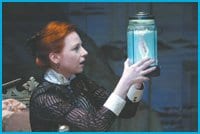Director Alisa Palmer is a rare figure on the Toronto-area theatre scene. She takes the visual aspects of a performance as seriously as her peers take dramaturgical dabbling or philosophical enquiring. Many of her fellow directors’ productions imply their underlying faith that radio is actually the best medium for expressing drama, but Palmer has a history of making the visual and movement components of a production as important to an audience as what it hears.
In the case of Belle Moral, Palmer achieves a thoroughly theatrical success in the best sense of that word. This is the latest work from Toronto playwright (and best-selling novelist) Ann-Marie MacDonald, and it received its premiere this month at the Shaw Festival.
Along with designer Judith Bowman and lighting designer Kevin Lamotte, Palmer makes the best possible use of the slightly awkward confines of the Court House Theatre in producing MacDonald’s melodramatic entertainment.
Set in an Edinburgh mansion in 1899, Belle Moral is an audacious attempt by MacDonald to inquire into science and art, the meaning of family, the dour yet playful character of the Scots, the Protestant ethic versus the delights of hedonism and feminism versus patriarchy – all this suffused by a serious dialectic about Darwinism.
The play is a revision of a much earlier effort and could do with even more work. There are too many moments when a hundred words are expected to do the work of 10. The ending in particular is a mess; its cheap sight gags and cheaper jokes are totally at odds with some very serious dialogue about scientific ethics and enquiry. It betrays the tone of the rest of the play, which is far more successful in maintaining a fine balance between humour, pathos and instruction.
Otherwise this is vintage MacDonald – long-winded perhaps but thought-provoking and fun.
The cast of Shaw veterans is mostly up to the task of impersonating some of the wildest characters seen on a festival stage in a long time. The main problem they share is retaining the evenness of their attempts at Scottish accents.
Donna Belleville is a sterling Aunt Flora, and Fiona Byrne playing Pearl MacIsaac creates a fine vision of that fearsome race, the seriously educated Scotswoman.
Peter Millard as Dr Reid works hard with Byrne in dealing with didactic dialogue as dense as any of George Bernard Shaw’s works, and Jeff Meadows has lots of fun (and the best costumes) with the “male hysteric” role.
Composer Paul Sportelli does a fine job, as does the uncredited person or persons responsible for an imaginative sound design.
Finally, a desperate plea. Would Toronto playwrights please cut out the stale Marmite jokes, especially since this particularly tasty treat wasn’t invented until three years after the events of this play occurred!

 Why you can trust Xtra
Why you can trust Xtra


